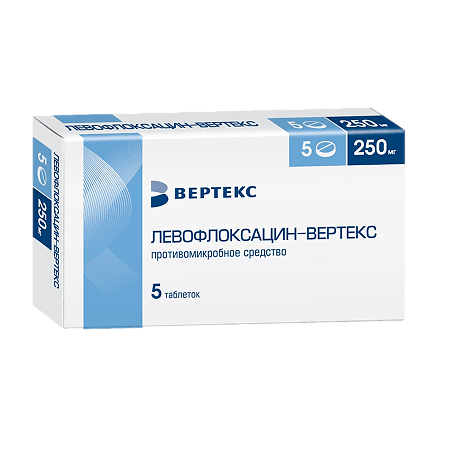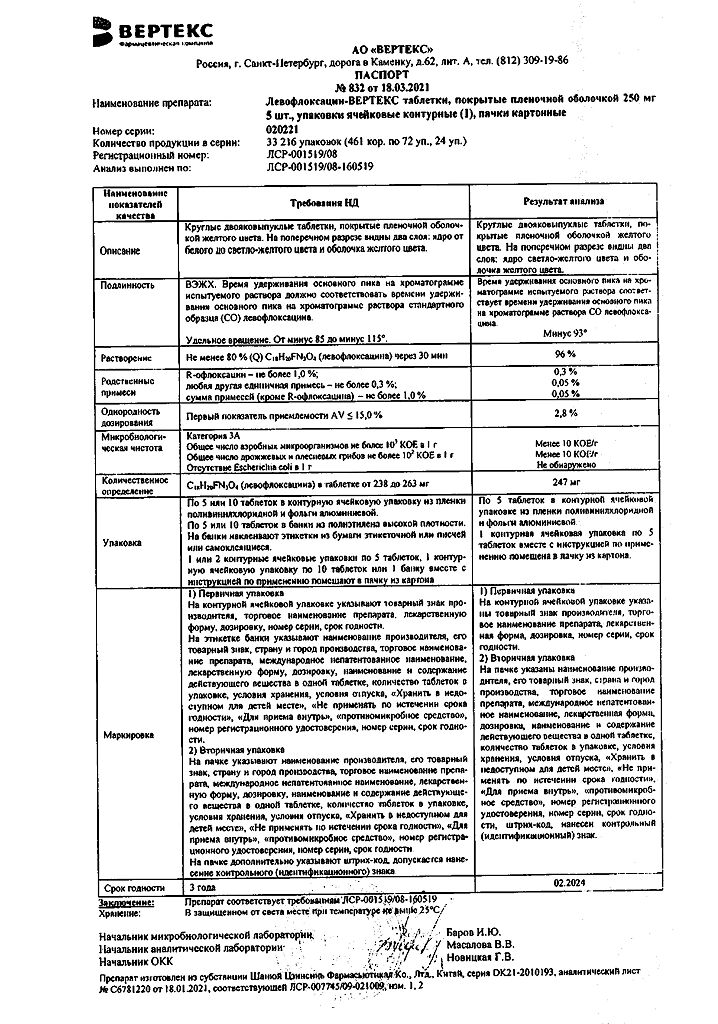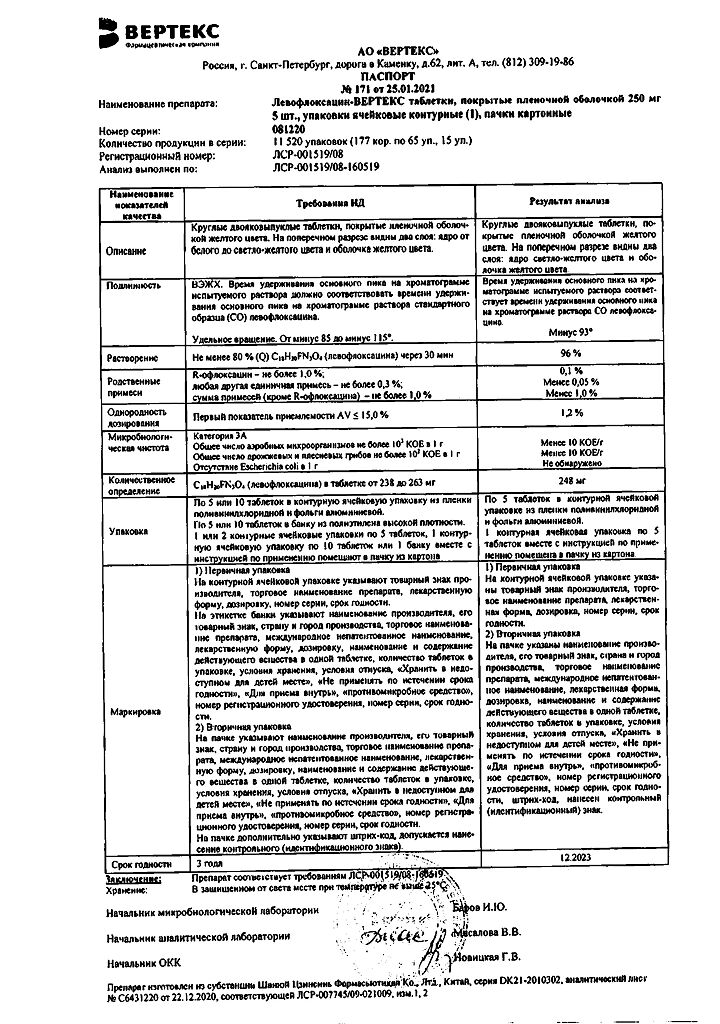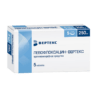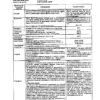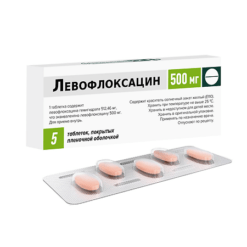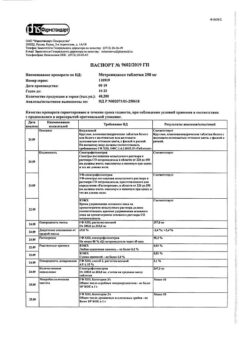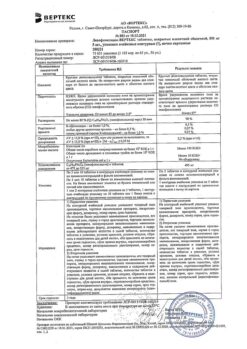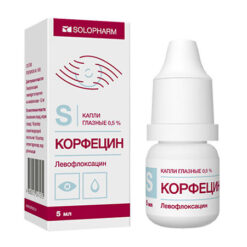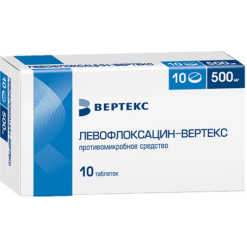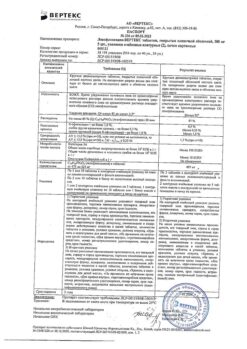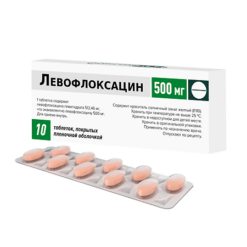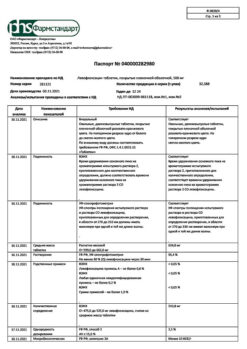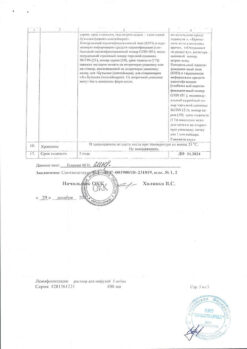No products in the cart.
Levofloxacin-Vertex, 250 mg 5 pcs
€1.00
Out of stock
(E-mail when Stock is available)
Description
Pharmacotherapeutic group
Antimicrobial agent – fluoroquinolone
ATX code
J01MA
Pharmacodynamics:
Levofloxacin is a synthetic broad-spectrum antibacterial agent of the fluoroquinolone group, the left-handed isomer ofloxacin. Levofloxacin blocks DNA-Giase and topoisomerase IV disrupts superspiralization and cross-linking of DNA breaks inhibits DNA synthesis and causes profound morphological changes in the cytoplasm of the cell wall and bacterial membranes.
Levofloxacin is active against most strains of microorganisms both in vitro and in vivo.
In vitro:
Sensitive microorganisms (minimum suppressive concentration (MDC) ≤ 2 mg/L; zone of inhibition ≥17 mm)
Aerobic Gram-positive microorganisms: Bacillus anthracis Corynebacterium diphtheriae Corynebacterium jeikeium Enterococcus faecalis Enterococcus spp. Listeria monocytogenes Staphylococcus coagulase-negative methi-S(I) (coagulase-negative methicillin-sensitive/moderately sensitive strains) Staphylococcus aureus methi-S (methicillin-sensitive strains) Staphylococcus epidermidis methi-S (methicillin-sensitive strains) Staphylococcus spp. CNS (coagulazonegative); Streptococcus spp. groups C and G Streptococcus agalactiae Streptococcus pneumoniae peni I/S/R (penicillin-sensitive/moderately sensitive/resistant strains) Streptococcus pyogenes Viridans streptococci peni-S/R (penicillin-sensitive/resistant strains).
Aerobic Gram-negative microorganisms: Acinetobacter baumannii Acinetobacter spp. Actinobacillus actinomycetemcomitans Citrobacter freundii Eikenella corrodens Enterobacter aerogenes Enterobacter cloacae Enterobacter spp. Escherichia coli Gardnerella vaginalis Haemophilus ducreyi Haemophilus influenzae ampi-S/R (ampicillin sensitive/resistant strains) Haemophilus parainfluenzae Helicobacter pylori Klebsiella oxytoca Klebsiella pneumoniae Klebsiella spp. Moraxella catarrhalis P+/(3- (beta-lactamase producing and non-producing strains) Morganella morganii Neisseria gonorrhoeae non PPNG/PPNG (penicillinase producing and non-producing strains) Neisseria meningitidis Pasteurella canis Pasteurella dagmatis Pasteurella multocida Pasteurella spp. Proteus mirabilis Proteus vulgaris Providencia rettgeri Providencia stuartii Providencia spp. Pseudomonas aeruginosa (hospital infections caused by Pseudomonas aeruginosa may require combined treatment) Pseudomonas spp. Serratia spp. Serratia marcescens Salmonella spp.
Anaerobic microorganisms: Bacteroides fragilis Bifidobacterium spp. Clostridium perfringens Fusobacterium spp. Peptostreptococcus spp. Propionibacterium spp. Veillonella spp.
Other microorganisms: Bartonella spp. Chlamydia pneumoniae Chlamydia psittaci Chlamydia trachomatis Legionella pneumophila Legionella spp. Mycobacterium spp. Mycobacterium leprae Mycobacterium tuberculosis Mycoplasma hominis Mycoplasma pneumoniae Rickettsia spp. Ureaplasma urealyticum.
Moderately sensitive microorganisms (MPC = 4 mg/L; inhibition zone 16-14 mm)
Aerobic Gram-positive microorganisms: Corynebacterium urealyticum Corynebacterium xerosis Enterococcus faecium Staphylococcus epidermidis methi-R (Methicillin-resistant strains) Staphylococcus haemolyticus methi-R (Methicillin-resistant strains).
Aerobic Gram-negative microorganisms: Campylobacter jejuni Campylobacter coli.
Anaerobic microorganisms: Prevotella spp. Porphyromonas spp.
Resistant microorganisms (MPC ≥ 8 mg/L; inhibition zone ≤ 13 mm)
Aerobic Gram-positive microorganisms: Staphylococcus aureus methi-R (methicillin-resistant strains) Staphylococcus coagulase-negative methi-R (coagulase-negative methicillin-resistant strains).
Aerobic Gram-negative microorganisms: Alcaligenes xylosoxidans.
Other microorganisms: Mycobacterium avium.
Resistance
Resistance to levofloxacin develops as a result of a stepwise process of mutations in the genes encoding both tin II topoisomerases: DNA-Gyrase and topoisomerase IV. Other mechanisms of resistance such as the mechanism of influence on the penetration barriers of the microbial cell (mechanism typical for Pseudomonas aeruginosa) and mechanism of efflux (active elimination of antimicrobial agent from the microbial cell) can also decrease the sensitivity of microorganisms to levofloxacin.
In view of the specific mechanism of action of levofloxacin there is usually no cross-resistance between levofloxacin and other antimicrobial agents.
Clinical efficacy (effectiveness in clinical studies in the treatment of infections caused by the following microorganisms)
Aerobic gram-positive microorganisms: Enterococcus faecalis Staphylococcus aureus Streptococcus pneumoniae Streptococcus pyogenes.
Aerobic Gram-negative microorganisms: Citrobacter Freundii Enterobacter cloacae Escherichia coli Haemophilus influenzae Haemophilus parainfluenzae Klebsiella pneumoniae Moraxella (Branhamella) catarrhalis Morganella morganii Proteus mirabilis Pseudomonas aeruginosa Serratia marcescens.
Other microorganisms: Chlamydia pneumoniae Legionella pneumophila Mycoplasma pneumoniae.
Pharmacokinetics:
Absorption
Levofloxacin is quickly and almost completely absorbed after oral administration. Food intake has little effect on the speed and completeness of absorption. Bioavailability of levofloxacin after oral administration is 99-100%. After a single dose of 500 mg of levofloxacin maximum concentration in plasma is 52 ± 12 mcg/ml time to reach maximum concentration – 13 h. Pharmacokinetics of levofloxacin is linear in dose range from 50 to 1000 mg. The equilibrium state of plasma concentrations of levofloxacin in administration of 500 mg 1 or 2 times per day is reached within 48 hours.
Distribution
The binding to plasma proteins is 30-40%. It penetrates well into organs and tissues: lungs, mucous membrane of bronchi, sputum, genitourinary system organs, bone tissue, cerebrospinal fluid, prostate gland, polymorphonuclear leukocytes, alveolar macrophages. After a single and repeated administration of 500 mg of levofloxacin, the volume of distribution averages 100 l.
Infiltration into the bronchial mucosa fluid epithelial lining alveolar macrophages
. After a single oral administration of 500 mg of levofloxacin, maximum concentrations of levofloxacin in bronchial mucosa and epithelial lining fluid were reached within 1 h or 4 h and were 83 µg/g and 108 µg/mL, respectively, with penetration rates into bronchial mucosa and epithelial lining fluid compared to plasma concentrations of 11-18 and 08-3, respectively.
After 5 days of oral administration of 500 mg of levofloxacin, mean concentrations of levofloxacin 4 hours after the last administration were 994 μg/mL in the epithelial lining fluid and 979 μg/mL in alveolar macrophages.
Penetration and pulmonary tissue
The maximum concentration in pulmonary tissue after oral administration of 500 mg of levofloxacin was approximately 113 µg/g and was reached 4-6 h after drug administration with penetration coefficients of 2-5 compared to plasma concentrations.
Alveolar fluid penetration
After 3 days of administration of 500 mg of levofloxacin once or twice daily, maximum concentrations of levofloxacin in alveolar fluid were reached 2-4 h after drug administration and were 40 and 67 µg/ml respectively with a penetration factor of 1 compared to the plasma concentration.
Bone penetration
Levofloxacin penetrates well into cortical and cancellous bone tissue in both proximal and distal femur with a penetration coefficient (bone tissue/plasma) of 01-3. Maximum concentration of levofloxacin in cancellous bone tissue of proximal femur after oral administration of 500 mg of the drug was approximately 15.1 mcg/g (2 h after drug administration).
Cerebrospinal fluid penetration
Levofloxacin does not readily penetrate into the cerebrospinal fluid.
Permeability to prostate tissue
After oral administration of 500 mg of levofloxacin once daily for 3 days, the average concentration of levofloxacin in prostate tissue was 87 mcg/g and the average prostate/plasma concentration ratio was 184.
Urinary concentrations
The mean urinary concentrations 8-12 hours after oral doses of 150,300 and 600 mg of levofloxacin were 44 µg/mL 91 µg/mL and 162 µg/mL, respectively.
Metabolism
Levofloxacin is metabolized to a small extent (5% of the dose taken). Its metabolites are demethyllevofloxacin and levofloxacin N-oxide which are excreted by the kidneys. Levofloxacin is stereochemically stable and does not undergo chiral conversions.
Elimation
Extracted mainly by the kidneys through glomerular filtration and tubular secretion. The elimination half-life (T1/2) is 6-8 hours. After oral administration, about 85% of the administered dose is excreted by the kidneys within 48 hours. A small part is excreted by the intestine (less than 4% of the taken dose is excreted within 72 hours). Total clearance of levofloxacin after a single dose of 500 mg is 175 ± 292 ml/minute.
There are no significant differences in pharmacokinetics of levofloxacin when administered intravenously and when administered orally, which confirms that intravenous and oral administration are interchangeable.
Pharmacokinetics in selected patient groups
The pharmacokinetics of levofloxacin do not differ in men and women.
Pharmacokinetics in elderly patients does not differ from that in younger patients except for differences in pharmacokinetics associated with differences in creatinine clearance (CK).
In renal insufficiency the pharmacokinetics of levofloxacin changes. As renal function decreases, renal excretion and renal clearance (CIR) decreases and T1/2 increases.
Indications
Indications
Infectious and inflammatory diseases caused by microorganisms sensitive to levofloxacin:
– acute sinusitis;
– exacerbation of chronic bronchitis;
– community-acquired pneumonia;
– complicated urinary tract infections (including pyelonephritis);
– uncomplicated urinary tract infections;
– chronic bacterial prostatitis;
– infections of the skin and soft tissues;
– anthrax through airborne transmission (prevention and treatment);
– tuberculosis (complex treatment of drug-resistant forms).
When using the drug Levofloxacin, official national recommendations on the proper use of antibacterial drugs should be taken into account, as well as the sensitivity of pathogenic microorganisms (see section “Special instructions”).
Pharmacological effect
Pharmacological effect
Pharmacotherapeutic group
Antimicrobial agent – fluoroquinolone
ATX code
J01MA
Pharmacodynamics:
Levofloxacin is a synthetic broad-spectrum antibacterial agent from the group of fluoroquinolones, a levorotatory isomer of ofloxacin. Levofloxacin blocks DNA gyrase and topoisomerase IV; disrupts supercoiling and cross-linking of DNA breaks; inhibits DNA synthesis; causes profound morphological changes in the cytoplasm, cell wall and membranes of bacteria.
Levofloxacin is active against most strains of microorganisms both in vitro and in vivo.
In vitro:
Sensitive microorganisms (minimum inhibitory concentration (MIC) ≤ 2 mg/l; zone of inhibition ≥17 mm)
Aerobic gram-positive microorganisms: Bacillus anthracis Corynebacterium diphtheriae Corynebacterium jeikeium Enterococcus faecalis Enterococcus spp. Listeria monocytogenes Staphylococcus coagulase-negative methi-S(I) (coagulase-negative methicillin-sensitive/moderately sensitive strains) Staphylococcus aureus methi-S (methicillin-sensitive strains) Staphylococcus epidermidis methi-S (methicillin-sensitive strains) Staphylococcus spp. CNS (coagulase negative); Streptococcus spp. groups C and G Streptococcus agalactiae Streptococcus pneumoniae peni I/S/R (penicillin-sensitive/moderately sensitive/resistant strains) Streptococcus pyogenes Viridans streptococci peni-S/R (penicillin-sensitive/resistant strains).
Aerobic gram-negative microorganisms: Acinetobacter baumannii Acinetobacter spp. Actinobacillus actinomycetemcomitans Citrobacter freundii Eikenella corrodens Enterobacter aerogenes Enterobacter cloacae Enterobacter spp. Escherichia coli Gardnerella vaginalis Haemophilus ducreyi Haemophilus influenzae ampi-S/R (ampicillin-sensitive/resistant strains) Haemophilus parainfluenzae Helicobacter pylori Klebsiella oxytoca Klebsiella pneumoniae Klebsiella spp. Moraxella catarrhalis P+/(3- (beta-lactamase producing and non-beta-lactamase producing strains) Morganella morganii Neisseria gonorrhoeae non PPNG/PPNG (penicillinase producing and non-producing strains) Neisseria meningitidis Pasteurella canis Pasteurella dagmatis Pasteurella multocida Pasteurella spp. Proteus mirabilis Proteus vulgaris Providencia rettgeri Providencia stuartii Providencia spp. Pseudomonas aeruginosa (hospital infections caused by Pseudomonas aeruginosa may require combination treatment) Pseudomonas spp. Serratia marcescens Salmonella spp.
Anaerobic microorganisms: Bacteroides fragilis Bifidobacterium spp. Clostridium perfringens Fusobacterium spp. Peptostreptococcus spp. Propionibacterium spp. Veillonella spp.
Other microorganisms: Bartonella spp. Chlamydia pneumoniae Chlamydia psittaci Chlamydia trachomatis Legionella pneumophila Legionella spp. Mycobacterium spp. Mycobacterium leprae Mycobacterium tuberculosis Mycoplasma hominis Mycoplasma pneumoniae Rickettsia spp. Ureaplasma urealyticum.
Moderately sensitive microorganisms (MIC = 4 mg/l; inhibition zone 16-14 mm)
Aerobic gram-positive microorganisms: Corynebacterium urealyticum Corynebacterium xerosis Enterococcus faecium Staphylococcus epidermidis methi-R (Methicillin-resistant strains) Staphylococcus haemolyticus methi-R (Methicillin-resistant strains).
Aerobic gram-negative microorganisms: Campylobacter jejuni Campylobacter coli.
Anaerobic microorganisms: Prevotella spp. Porphyromonas spp.
Resistant microorganisms (MIC ≥ 8 mg/l; inhibition zone ≤ 13 mm)
Aerobic gram-positive microorganisms: Staphylococcus aureus methi-R (methicillin-resistant strains) Staphylococcus coagulase-negative methi-R (coagulase-negative methicillin-resistant strains).
Aerobic gram-negative microorganisms: Alcaligenes xylosoxidans.
Other microorganisms: Mycobacterium avium.
Resistance
Resistance to levofloxacin develops as a result of a step-by-step process of mutations in the genes encoding both Tin II topoisomerases: DNA gyrase and topoisomerase IV. Other mechanisms of resistance, such as the mechanism of influencing the penetration barriers of the microbial cell (a mechanism characteristic of Pseudomonas aeruginosa) and the mechanism of efflux (active removal of the antimicrobial agent from the microbial cell) may also reduce the sensitivity of microorganisms to levofloxacin.
Due to the peculiarities of the mechanism of action of levofloxacin, cross-resistance between levofloxacin and other antimicrobial agents is not usually observed.
Clinical efficacy (effectiveness in clinical studies in the treatment of infections caused by the microorganisms listed below)
Aerobic gram-positive microorganisms: Enterococcus faecalis Staphylococcus aureus Streptococcus pneumoniae Streptococcus pyogenes.
Aerobic gram-negative microorganisms: Citrobacter Freundii Enterobacter cloacae Escherichia coli Haemophilus influenzae Haemophilus parainfluenzae Klebsiella pneumoniae Moraxella (Branhamella) catarrhalis Morganella morganii Proteus mirabilis Pseudomonas aeruginosa Serratia marcescens.
Other microorganisms: Chlamydia pneumoniae Legionella pneumophila Mycoplasma pneumoniae.
Pharmacokinetics:
Absorption
Levofloxacin is rapidly and almost completely absorbed after oral administration. Food intake has little effect on the speed and completeness of absorption. The bioavailability of levofloxacin after oral administration is 99-100%. After taking a single dose of 500 mg of levofloxacin, the maximum concentration in blood plasma is 52 ± 12 μg/ml, the time to reach the maximum concentration is 13 hours. The pharmacokinetics of levofloxacin is linear in the dose range from 50 to 1000 mg. The equilibrium state of the concentration of levofloxacin in the blood plasma when taking 500 mg 1 or 2 times a day is achieved within 48 hours.
Distribution
Communication with blood plasma proteins is 30-40%. Penetrates well into organs and tissues: lungs, bronchial mucosa, sputum, genitourinary system, bone tissue, cerebrospinal fluid, prostate gland, polymorphonuclear leukocytes, alveolar macrophages. After a single and repeated dose of 500 mg of levofloxacin, the volume of distribution averages 100 liters.
Penetration into the bronchial mucosa fluid of the epithelial lining alveolar macrophages
After a single oral dose of 500 mg of levofloxacin, the maximum concentrations of levofloxacin in the bronchial mucosa and epithelial lining fluid were achieved within 1 hour or 4 hours and amounted to 83 mcg/g and 108 mcg/ml, respectively, with penetration coefficients into the bronchial mucosa and epithelial lining fluid compared with the concentration in the blood plasma of the components 11-1.8 and 08-3 respectively.
After 5 days of oral administration of 500 mg levofloxacin, the mean concentrations of levofloxacin 4 hours after the last dose in the fluid of the epithelial lining were 994 μg/ml and in alveolar macrophages – 979 μg/ml.
Penetration and lung tissue
The maximum concentration in the lung tissue after oral administration of 500 mg of levofloxacin was approximately 113 mcg/g and was achieved 4-6 hours after dosing with penetration coefficients of 2-5 compared to plasma concentrations.
Penetration into alveolar fluid
After 3 days of taking 500 mg of levofloxacin 1 or 2 times a day, the maximum concentrations of levofloxacin in the alveolar fluid were reached 2-4 hours after taking the drug and were 40 and 67 mcg/ml, respectively, with a penetration coefficient of 1 compared with the concentration in the blood plasma.
Penetration into bone tissue
Levofloxacin penetrates well into cortical and cancellous bone tissue in both the proximal and distal parts of the femur with a penetration coefficient (bone tissue/blood plasma) of 01-3. The maximum concentration of levofloxacin in the cancellous bone tissue of the proximal femur after taking 500 mg of the drug orally was approximately 15.1 mcg/g (2 hours after dosing).
Penetration into the cerebrospinal fluid
Levofloxacin penetrates poorly into the cerebrospinal fluid.
Penetration into prostate tissue
After oral administration of 500 mg of levofloxacin once daily for 3 days, the average concentration of levofloxacin in prostate tissue was 87 mcg/g; the average prostate/blood plasma concentration ratio was 184.
Concentrations in urine
Mean urinary concentrations 8 to 12 hours after oral doses of 150,300 and 600 mg of levofloxacin were 44 mcg/mL, 91 mcg/mL, and 162 mcg/mL, respectively.
Metabolism
Levofloxacin is metabolized to a small extent (5% of the dose taken). Its metabolites are demethyllevofloxacin and levofloxacin N-oxide, which are excreted by the kidneys. Levofloxacin is stereochemically stable and does not undergo chiral transformations.
Removal
It is excreted from the body primarily by the kidneys by glomerular filtration and tubular secretion. The half-life (T1/2) is 6-8 hours. After oral administration, approximately 85% of the dose taken is excreted by the kidneys within 48 hours. A small part is excreted by the intestines (less than 4% of the dose taken is excreted within 72 hours). The total clearance of levofloxacin after a single dose of 500 mg is 175 ± 292 ml/min.
There are no significant differences in the pharmacokinetics of levofloxacin when administered intravenously and when administered orally, which confirms that oral administration and intravenous administration are interchangeable.
Pharmacokinetics in selected patient groups
The pharmacokinetics of levofloxacin do not differ between men and women.
Pharmacokinetics in elderly patients do not differ from those in young patients, with the exception of differences in pharmacokinetics associated with differences in creatinine clearance (CC).
In renal failure, the pharmacokinetics of levofloxacin changes. As renal function declines, renal excretion and renal clearance (CIR) decrease and T1/2 increases.
Special instructions
Special instructions
Hospital-acquired infections caused by Pseudomonas aeruginosa may require combination treatment.
The prevalence of acquired resistance in cultured strains of microorganisms may vary by geographic region and over time. Therefore, country-specific information on levofloxacin resistance is required. For the treatment of severe infections or if treatment is ineffective, a microbiological diagnosis must be established with the isolation of the pathogen and determination of its sensitivity to levofloxacin. Staphylococcus aureus (methicillin-resistant strains). There is a high probability that methicillin-resistant Staphylococcus aureus will be resistant to fluoroquinolones including levofloxacin. Therefore, levofloxacin is not recommended for the treatment of established or suspected infections caused by methicillin-resistant Staphylococcus aureus if laboratory tests have not confirmed the sensitivity of this microorganism to levofloxacin.
Patients predisposed to developing seizures. Like other quinolones, levofloxacin should be used with great caution in patients with a predisposition to seizures. Such patients include patients with previous lesions of the central nervous system such as stroke, severe traumatic brain injury; patients simultaneously receiving drugs that lower the seizure threshold of the brain such as fenbufen and other similar NSAIDs or other drugs that lower the seizure threshold such as theophylline (see “Interaction with other drugs”).
Pseudomembranous colitis. Diarrhea that develops during or after treatment with levofloxacin, especially severe, persistent and/or bloody, may be a symptom of pseudomembranous colitis caused by Clostridium difficile. If pseudomembranous colitis is suspected, treatment with Levofloxacin should be stopped immediately and specific antibiotic therapy (vancomycin teicoplanin or oral metronidazole) should be started immediately. Drugs that inhibit intestinal motility are contraindicated.
Tendonitis. Rarely observed, tendonitis with quinolones including levofloxacin can lead to rupture of tendons including the Achilles tendon. This side effect can develop within 48 hours after starting treatment and can be bilateral. Elderly patients are more prone to developing tendinitis. The risk of tendon rupture may be increased when taking corticosteroids concomitantly. If tendonitis is suspected, treatment with Levofloxacin should be stopped immediately and appropriate treatment of the affected tendon should be initiated, for example by ensuring sufficient immobilization (see sections “Contraindications” and “Side Effects”).
Hypersensitivity reactions. Levofloxacin may cause serious, potentially fatal hypersensitivity reactions (angioedema, anaphylactic shock) even at initial doses (see Side Effects section). Patients should immediately stop taking the drug and consult a doctor.
Severe bullous reactions. Cases of severe bullous skin reactions such as Stevens-Johnson syndrome or toxic epidermal necrolysis have been observed when taking levofloxacin (see section “Side effects”). In case of development of any reactions from the skin or mucous membranes, the patient should immediately consult a doctor and not continue treatment until his consultation.
Disorders of the liver and biliary tract. Cases of hepatic necrosis, including the development of fatal liver failure, have been reported with the use of levofloxacin, mainly in patients with severe underlying diseases such as sepsis (see section “Side effects”). Patients should be warned to stop treatment and seek immediate medical attention if signs and symptoms of liver damage appear, such as anorexia, jaundice, dark urine, itching and abdominal pain.
Patients with renal failure. Since levofloxacin is excreted mainly through the kidneys in patients with impaired renal function, mandatory monitoring of renal function is required, as well as adjustment of the dosage regimen (see section “Method of administration and dosage”). When treating elderly patients, it should be borne in mind that patients in this group often experience impaired night function (see section “Method of administration and dosage”).
Preventing the development of photosensitivity reactions. Although photosensitivity during the use of levofloxacin develops very rarely, to prevent its development, patients are not recommended to undergo unnecessarily strong solar or artificial ultraviolet irradiation (for example, visiting a solarium) during treatment and for 48 hours after the end of treatment with levofloxacin.
Superinfection. As with the use of other antibiotics, the use of levofloxacin, especially for a long time, can lead to increased proliferation of microorganisms (bacteria and fungi) that are insensitive to it, which can cause changes in the microflora that is normally present in humans. As a result, superinfection may develop. Therefore, during treatment, it is imperative to re-evaluate the patient’s condition and, if superinfection develops during treatment, take appropriate measures.
Prolongation of the QT interval. Very rare cases of QT prolongation have been reported in patients taking fluoroquinolones including levofloxacin. When using fluoroquinolones, including levofloxacin, caution should be exercised in patients with known risk factors for prolongation of the QT interval: in patients with uncorrected electrolyte disturbances (with hypokalemia and hypomagnesemia); with congenital long QT syndrome; with heart disease (heart failure, myocardial infarction, bradycardia); while taking medications that can prolong the QT interval, such as antiarrhythmic drugs of classes IA and III, tricyclic and tetracyclic antidepressants, neuroleptics, macrolides, antifungal imidazole derivatives, some antihistamines, including astemizole terfenadine ebastine. Elderly and female patients may be more sensitive to drugs that prolong the QT interval. Therefore, fluoroquinolones, including levofloxacin, should be used with caution (see sections “With caution”, “Side effects”, “Interaction with other drugs”).
Patients with glucose-6-phosphate dehydrogenase deficiency. Patients with latent or manifest glucose-6-phosphate dehydrogenase deficiency are predisposed to hemolytic reactions when treated with quinolones, which should be taken into account when treated with levofloxacin.
Hypo- and hyperglycemia (dysglycemia). As with the use of other quinolones, cases of hyperglycemia and hypoglycemia have been observed when using levofloxacin, usually in patients with diabetes mellitus receiving concomitant treatment with oral hypoglycemic drugs (for example, glibenclamide) or insulin drugs. Cases of hypoglycemic coma have been reported. In patients with diabetes mellitus, monitoring of blood glucose concentration is required (see “Side effects”).
Peripheral neuropathy. In patients taking fluoroquinolones including levofloxacin. Sensory and sensorimotor peripheral neuropathy, the onset of which can be rapid, has been noted. If the patient develops symptoms of neuropathy, use of Levofloxacin should be discontinued. This minimizes the possible risk of developing irreversible changes.
Exacerbation of pseudoparalytic myasthenia gravis. Fluoroquinolones, including levofloxacin, have neuromuscular blocking activity and may increase muscle weakness in patients with myasthenia gravis. Adverse reactions, including pulmonary failure requiring mechanical ventilation and death, have been associated with the use of fluoroquinolones in patients with myasthenia gravis. The use of levofloxacin in patients with an established diagnosis of pseudoparalytic myasthenia gravis is not recommended (see section “Side Effects”).
Application for airborne anthrax infection. The use of levofloxacin in humans for this indication is based on data on the sensitivity of Bacillus anthracis to it from in vitro studies and experimental studies conducted in animals, as well as on limited data from the use of levofloxacin in humans. Treating physicians should refer to national and/or international documents that reflect the collectively developed point of view on the treatment of anthrax.
Psychotic reactions. With the use of quinolones, including levofloxacin, the development of psychotic reactions has been reported, which in very rare cases progressed to the development of suicidal thoughts and behavior disorders with self-harm (sometimes after taking a single dose of levofloxacin) (see section “Side effects”). If such reactions develop, treatment with Levofloxacin should be discontinued and appropriate therapy should be prescribed. The drug should be prescribed with caution to patients with psychosis or patients with a history of mental illness.
Visual impairment. If any visual impairment develops, immediate consultation with an ophthalmologist is necessary (see section “Side effects”).
Effect on laboratory tests. In patients taking levofloxacin, determination of opiates in urine may lead to false-positive results which should be confirmed by more specific methods. Levofloxacin may inhibit the growth of Mycobacterium tuberculosis and subsequently lead to false-negative results of the bacteriological diagnosis of tuberculosis.
Impact on the ability to drive vehicles. Wed and fur.:
During therapy with levofloxacin, you should refrain from driving vehicles and engaging in potentially hazardous activities that require increased concentration and speed of psychomotor reactions, as dizziness, drowsiness and visual disturbances may develop (see section “Side Effects”).
Active ingredient
Active ingredient
Levofloxacin
Composition
Composition
Yellow film-coated tablets, round, biconvex, light yellow at the break; tablet weight 330 mg.
1 tab. Levofloxacin (as hemihydrate) 250 mg
Excipients:
sodium croscarmellose (primellose) 7 mg,
magnesium stearate 3.2 mg,
medium molecular weight polyvinylpyrrolidone 14 mg,
microcrystalline cellulose 21.6 mg,
colloidal silicon dioxide (Aerosil) 5 mg,
talc 6.4 mg,
pregelatinized starch (Starch-1500) 12.8 mg.
Shell composition:
Opadry II (partially hydrolyzed polyvinyl alcohol) 4 mg, macrogol (polyethylene glycol 3350) 2.02 mg, talc 1.48 mg, titanium dioxide 1.459 mg, aluminum varnish based on yellow quinoline (E104) 0.84 mg, dye iron oxide (II) (E172) 0.198 mg, aluminum varnish based on indigo carmine (E132) 0.003 mg.
Contraindications
Contraindications
– Hypersensitivity to levofloxacin or other quinolones, as well as to any of the components of the drug;
– epilepsy;
– tendon damage due to previous treatment with quinolones;
– pseudoparalytic myasthenia gravis (myasthenia gravis);
– childhood and adolescence up to 18 years of age (due to the incompleteness of skeletal growth, since the risk of damage to cartilaginous growth points cannot be completely eliminated);
– pregnancy (the risk of damage to the cartilaginous growth points of the fetus cannot be completely excluded);
– the period of breastfeeding (the risk of damage to the cartilaginous growth points of bones in a child cannot be completely eliminated).
With caution:
– Predisposition to convulsive reactions (atherosclerosis of cerebral vessels, cerebrovascular accidents (history), organic diseases of the central nervous system, simultaneous use of drugs that reduce the threshold of convulsive readiness of the brain, for example fenbufen theophylline);
– deficiency of glucose-6-phosphate dehydrogenase (increased risk of hemolytic reactions during treatment with quinolones);
– impaired renal function (mandatory monitoring of renal function is required, as well as correction of the dosage regimen, see section “Method of administration and dosage”);
– known risk factors for prolongation of the QT interval: elderly patients, female patients, uncorrected electrolyte disturbances (for example, hypokalemia, hypomagnesemia), congenital long QT syndrome, heart disease (heart failure, myocardial infarction, bradycardia), simultaneous use of drugs that prolong the QT interval (class IA and class III antiarrhythmics, tricyclic and tetracyclic antidepressants, antipsychotics, macrolides, antifungals imidazole derivatives, some antihistamines including astemizole terfenadine ebastine);
– in patients with diabetes mellitus receiving oral hypoglycemic drugs such as glibenclamide or insulin drugs (the risk of hypoglycemia increases);
– severe adverse reactions to other fluoroquinolones such as severe neurological reactions (increased risk of similar adverse reactions when using levofloxacin);
– history of psychosis and other mental disorders;
– hepatic porphyria.
Side Effects
Side Effects
Classification of the incidence of side effects according to the recommendations of the World Health Organization (WHO):
very often >1/10;
often from > 1/100 to < 1/10;
infrequently from > 1/1000 to < 1/100;
rarely from > 1/10000 to < 1/1000;
very rare <1/10000 including isolated reports;
frequency unknown – based on available data, it is not possible to determine the frequency of occurrence.
Cardiac disorders:
rarely – sinus tachycardia, palpitations;
frequency unknown – prolongation of the QT interval, ventricular arrhythmias, ventricular tachycardia of the “pirouette” type, which can lead to cardiac arrest (See sections “Overdose” “Special instructions”).
Blood and lymphatic system disorders:
uncommon – leukopenia, eosinophilia; rarely – neutropenia, thrombocytopenia;
frequency unknown – pancytopenia, agranulocytosis, hemolytic anemia.
Nervous system disorders:
often – headache, dizziness;
infrequently – drowsiness, tremor, dysgeusia (taste perversion);
rarely – paresthesia, convulsions (see section “Special instructions”);
frequency unknown – peripheral sensory neuropathy peripheral sensorimotor neuropathy dyskinesia extrapyramidal disorders ageusia (loss of taste) parosmia (disorder of the sense of smell, especially the subjective sensation of an objectively absent smell) including loss of smell syncope benign intracranial hypertension.
Visual disorders:
very rarely – visual disturbances such as blurred visible images;
frequency unknown – transient loss of vision.
Hearing and labyrinth disorders:
infrequently – vertigo (feeling of deviation or spinning of one’s own body or surrounding objects);
rarely – ringing in the ears;
frequency unknown – hearing loss, hearing loss.
Disorders of the respiratory system of the chest and mediastinum:
infrequently – shortness of breath;
frequency unknown – bronchospasm, allergic pneumonitis.
Gastrointestinal disorders:
often – diarrhea, vomiting, nausea;
uncommon – abdominal pain, dyspepsia, flatulence, constipation;
frequency unknown – hemorrhagic diarrhea which in very rare cases may be a sign of enterocolitis including pseudomembranous colitis) (see section “Special instructions”) pancreatitis.
Renal and urinary tract disorders:
infrequently – increased concentration of creatinine in blood plasma;
rarely – acute renal failure (for example, due to the development of interstitial nephritis).
Disorders of the skin and subcutaneous tissues:
uncommon – rash, itching, urticaria, hyperhidrosis;
frequency unknown – toxic epidermal necrolysis Stevens-Johnson syndrome, exudative erythema multiforme, photosensitivity reaction (see section “Special Instructions”), leukocytoclastic vasculitis, stomatitis.
Adverse reactions from the skin and mucous membranes can sometimes develop even after taking the first dose of the drug.
Musculoskeletal and connective tissue disorders:
uncommon – arthralgia, myalgia;
rarely – tendon damage including tendinitis; muscle weakness, which can be especially dangerous in patients with pseudoparalytic myasthenia gravis (see section “Special instructions”);
frequency unknown – rhabdomyolysis tendon rupture (this side effect can be observed within 48 hours after the start of treatment and can be bilateral) ligament tears muscle tears arthritis.
Metabolic and nutritional disorders:
infrequently – anorexia;
rarely – hypoglycemia, especially in patients with diabetes mellitus (possible signs of hypoglycemia: voracious appetite, nervousness, perspiration, trembling);
frequency unknown – hyperglycemia, hypoglycemic coma (see section “Special instructions”).
Infectious and parasitic diseases:
infrequently – fungal infections, development of resistance of pathogenic microorganisms.
Vascular disorders:
rarely – decreased blood pressure;
Common disorders:
infrequently – asthenia; rarely – pyrexia;
frequency unknown – pain (including pain in the back, chest and limbs).
Immune system disorders:
rarely – angioedema;
frequency unknown – anaphylactic shock, anaphylactoid shock.
Anaphylactic and anaphylactoid reactions can sometimes develop even after taking the first dose of the drug.
Disorders of the liver and biliary tract:
often – increased activity of liver enzymes increased activity
alkaline phosphatase and gamma-glutamyltransferase;
infrequently – increased concentration of bilirubin in the blood plasma;
frequency unknown – severe liver failure including cases of acute liver failure, sometimes fatal, especially in patients with a severe underlying disease (for example, patients with sepsis) hepatitis jaundice.
Mental disorders:
often – insomnia;
infrequently – feeling of restlessness anxiety confusion;
rarely – mental disorders (for example, hallucinations, paranoia), depression, agitation (excitement), sleep disturbances, nightmares;
frequency unknown – mental disorders with behavioral disorders with self-harm including suicidal thoughts and suicide attempts.
Other possible side effects related to all fluoroquinolones:
very rarely – exacerbation of porphyria.
Interaction
Interaction
Preparations containing magnesium aluminum iron and zinc didanosine
Medicines containing divalent or trivalent cations such as zinc or iron salts (medicines for the treatment of anemia), magnesium- and/or aluminum-containing medicines (such as antacids), didanosine (only dosage forms containing aluminum or magnesium as a buffer) are recommended to be taken at least 2 hours before or 2 hours after taking Levofloxacin.
Calcium salts
Calcium salts have a minimal effect on the absorption of levofloxacin when taken orally.
Sucralfate
The effect of levofloxacin is significantly weakened by the simultaneous use of sucralfate (a drug for protecting the gastric mucosa). It is recommended to take sucralfate 2 hours after taking Levofloxacin.
Theophylline fenbufen or similar drugs from the group of non-steroidal anti-inflammatory drugs (NSAIDs) that reduce the threshold for convulsive readiness of the brain.
No pharmacokinetic interaction of levofloxacin with theophylline was detected. However, with the simultaneous use of quinolones and theophylline, NSAIDs and other drugs that reduce the threshold of convulsive readiness of the brain, a pronounced decrease in the threshold of convulsive readiness of the brain is possible.
The concentration of levofloxacin while taking fenbufen increases only by 13%.
Indirect anticoagulants (vitamin K antagonists)
In patients treated with levofloxacin in combination with indirect anticoagulants (for example, warfarin), an increase in prothrombin time/international normalized ratio and/or the development of bleeding, including severe bleeding, was observed. Therefore, with the simultaneous use of indirect anticoagulants and levofloxacin, regular monitoring of blood coagulation parameters is necessary.
Probenecid and cimetidine
With the simultaneous use of drugs that interfere with renal tubular secretion such as probenecid and cimetidine and levofloxacin, caution should be exercised, especially in patients with renal failure.
The elimination (renal clearance) of levofloxacin is slowed down by cimetidine by 24% and probenecid by 34%. This is unlikely to be of clinical significance if renal function is normal.
Cyclosporine
Levofloxacin increased T1/2 of cyclosporine by 33%. Since this increase is clinically insignificant, no dose adjustment of cyclosporine is required when used concomitantly with levofloxacin.
Glucocorticosteroids
Concomitant use of glucocorticosteroids increases the risk of tendon rupture.
Medicines that prolong the OT interval
Levofloxacin, like other fluoroquinolones, should be used with caution in patients receiving drugs that prolong the QT interval (class IA and III antiarrhythmics, tricyclic and tetracyclic antidepressants, neuroleptics, macrolides, antifungal imidazole derivatives, some antihistamines, including astemizole terfenadine ebastine).
Others
Clinical and pharmacological studies conducted to study the possible pharmacokinetic interactions of levofloxacin with digoxin, glibenclamide, ranitidine and warfarin showed that the pharmacokinetics of levofloxacin, when used simultaneously with these drugs, does not change sufficiently to be of clinical significance.
Overdose
Overdose
Symptoms
Symptoms of an overdose of levofloxacin appear at the level of the central nervous system (confusion, dizziness, disturbances of consciousness and seizure-type convulsions). In addition, gastrointestinal disorders (for example, nausea) and erosive lesions of the mucous membrane and prolongation of the QT interval may occur.
Treatment
In case of overdose, careful monitoring of the patient is required, including electrocardiogram monitoring.
Treatment should be symptomatic. In case of acute overdose, gastric lavage and administration of antacids are indicated to protect the gastric mucosa. Levofloxacin is not eliminated by dialysis (hemodialysis, peritoneal dialysis and continuous peritoneal dialysis). There is no specific antidote.
Storage conditions
Storage conditions
In a place protected from light at a temperature not exceeding 25 ° C.
Keep out of the reach of children.
Shelf life
Shelf life
3 years.
Do not use after expiration date.
Manufacturer
Manufacturer
Vertex, Russia
Additional information
| Shelf life | 3 years. Do not use after the expiration date. |
|---|---|
| Conditions of storage | In the dark place at a temperature not exceeding 25 °С. Store out of the reach of children. |
| Manufacturer | Vertex, Russia |
| Medication form | pills |
| Brand | Vertex |
Other forms…
Related products
Buy Levofloxacin-Vertex, 250 mg 5 pcs with delivery to USA, UK, Europe and over 120 other countries.

